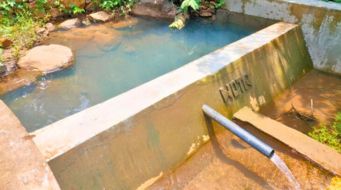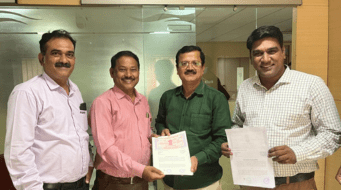
- Water Quality Assessment at a community well in Ambit village of Akole block
By Zuhail T & Renie Thomas
Poor groundwater quality during drought can have serious repercussions on health, agriculture, income and sanitation levels of the village communities. The present study looks at the upstream and downstream groundwater quality changes. The changing rainfall patterns, deteriorating groundwater quality, recurring shortage of drinking water and prolonged water scarce days across villages of Mula-Pravara sub-basin call for an urgent need to relook at the current strategies of quality assessments at the local level and its dissemination through awareness programmes. The preliminary water quality study is being carried out to highlight the gaps that exist at different levels – administrative, watershed and aquifer that impede effective adaptation to poor groundwater quality of communities during times of drought.
Many parts of Maharashtra, had been reeling under severe hydrological droughts for the past three-four years. The social media was buzzing with a plethora of issues revolving around water scarcity, such as farmer suicides, water-train to Latur village, crop failure and migration of farmers to urban cities. These stories highlighted the currently critical water scarcity situation that many parts of Maharashtra struggled with. The summer was a witness to a constant tussle over the scarce groundwater resource, amidst which the issue of groundwater quality was taking a back seat. During times of drought, addressing water demands is important, but it is also vital to ensure the availability of clean and safe drinking water which gets polluted due to increased algal and bacterial blooms, total dissolved solids, and nitrates.
As this situation of water scarcity persists year after year, we reached out to villages in the Mula and Pravara sub-basins of Maharashtra in the month of May when summer is at its peak. The idea was not just to witness and assess the severity of this crisis, but also to understand the causes of deteriorating groundwater quality from a geo-hydrological and anthropogenic perspective. The present study – panning 51 villages across 8 blocks of Akole, Sangamner, Sinnar, Ahmednagar, Parner, Rahuri, Rahata and Junnar in the Mula-Pravara sub-basins – is aimed at assessing the groundwater quality.
In the region, the underlying geological strata consist of hard massive basalts of varied thickness that play a major role in how groundwater occurs in otherwise impervious hard rock. It also influences how water chemistry changes with depth while interacting with different underlying basaltic flow units. Further, the current groundwater usage patterns and people’s interactions with this subsurface blue gold have far-reaching environmental effects on whether it is fit for drinking and irrigation purposes.
During our field visit in May, we tested pH, temperature, electrical conductivity, total dissolved solids, and salinity immediately after sample collection because it gives us a primary insight on the quality of water including its acidity/alkalinity and salinity. Samples were also collected and taken back to labs for analysis and determination of the following parameters: Alkalinity, Total hardness, Calcium hardness, Magnesium hardness, Chlorides, Sodium, Potassium, Nitrates, Phosphates and Total coliforms.
Most villages identified for the study were usually supplied with tanker water sourced from private borewells due to the village open wells running dry or being contaminated. During our field visits to these villages, community members shared a litany of complaints with us – little or no water availability for agriculture, contaminated groundwater that is not usable for agriculture, no potable drinking water for consumption, highly saline soils, loss of soil moisture, degrading natural vegetation, less pasture for livestock, migration of village folks to cities, recurring sickness like gastro-intestinal problems and kidney stones[1].
Lack of monitoring system
In the few villages of Akole that we collected water samples from, the villagers informed that we were the first ones to test the water for its quality; as water quality testing is carried out only at selected locations. Though the villagers were aware of the basic properties such as level of salt, odour, and colour, they were unable to identify the actual reason behind it. This shows that there aren’t any monitoring systems in place at village level or an awareness program for the villagers about water quality. The poor water quality situation comes to light only when reports of people being admitted to the hospitals are highlighted in newspapers.
In Warangushi of Akole block, the open wells had little or virtually no water. This village, situated at an altitude of 810 m above mean sea level, depends primarily on groundwater for meeting drinking and irrigation needs. The village is so remote that there is hardly any connectivity to major civilization. The wells in the hard rock aquifers have been literally tapped to dryness yielding little or no water. The situation in most of the villages in Akole was similar. As villagers struggled and fought to get water without even caring for its poor quality and muddy nature, we realized the immense stress and hardship they face on a day-to-day basis. At this point, one needs to ask ‘Does water quality take priority over water availability?’

- Children fetching water at Warungushi village
The punctured Pravara River segment
During times of severe water shortages, extreme steps of digging up wells right on the river bed, exposing groundwater to evaporation and over-extraction of groundwater increases salinity issues. Also, intensive agriculture depletes the groundwater table while the rampant use of pesticides along river banks increases nitrate contamination in groundwater. Such encroachment of wells along dried up river segments like the one in Chikali village, and sand mining destroys natural filtering function of alluvial bed in the river. Such unauthorized activities highlight how ineffective water governance systems are at different levels. If such unchecked haphazard activities take place in the long run, further contamination of groundwater will make the communities situated downstream.

- Dozens of open wells have dug into the bed of the Pravara River in Chikali village of Sangamner block
Increasing salinity levels in wells
A majority of villages of Ahmednagar, Rahata, Rahuri and Sangamner blocks located downstream of the Mula-Pravara sub-basin show very high salinity levels in their wells. Though increased salinity is dominantly governed by natural processes, increased human activities in the recent decade have accelerated salinity levels. Less rainfall, annual fluctuations in monsoonal rainfall increase dissolution of rock minerals, evaporation, and depletion of groundwater due to excessive pumping and agriculture practices, all contribute towards excess salinity. Groundwater is so saline that irrigating the land with such water has made the soils unproductive. Communities completely depend on tankers to fulfil their drinking water needs. Migration for work to the nearest towns is seen as the only way out for the village communities to address unemployment problems aggravating due to unproductive lands and scarce & poor water conditions.

- High salinity levels make the water from this farmers borewell unusable for drinking or agriculture purposes, Shiwapur village of Sangamner block
Future steps
As per our season-one (summer) analysis, the upstream villages located in Akole show far better drinking water quality standards compared to the other blocks located downstream. The general bacteriological contamination has been documented in almost all samples collected across the sub-basin. In times of drought, most of the government machinery is geared towards providing water, but the reach out is limited and quite irregular. In some villages, it took weeks for tanker water to reach. Timely steps are also needed towards improving and protecting drinking water quality that is available at the village level. These steps include monitoring of changes in the water quality during different seasons for timely advise on water treatments, identifying water sources that can have adverse impacts on community health, suggesting measures on turning towards sustainable agriculture, building capacities of communities to adapt to such harsh conditions and providing alternate options to the impacts of declining state of water quality and quantity.
Sourcing safe and potable drinking water for consumption, whilst ensuring sustained yield from aquifers, is a fine balance that requires an integrated approach. This can be achieved when different stakeholders including farmers, policy-makers, researchers, local organisations and government agencies interplay to bring about changes in the current water quality management practices. It is necessary to regularly monitor the water quality at the village level and to involve the community members in this process. There is a dire need for alternative plans for the upkeep of our groundwater quality, where people are aware and prepared to take prompt measures.
[1] Deshmukh, K. K. (2012). Ground water quality evaluation with special reference to nitrate pollution in the Sangamner area, Ahmednagar district, Maharashtra, India. WIT Transactions on Ecology and the Environment, 164, pp 79-88.





